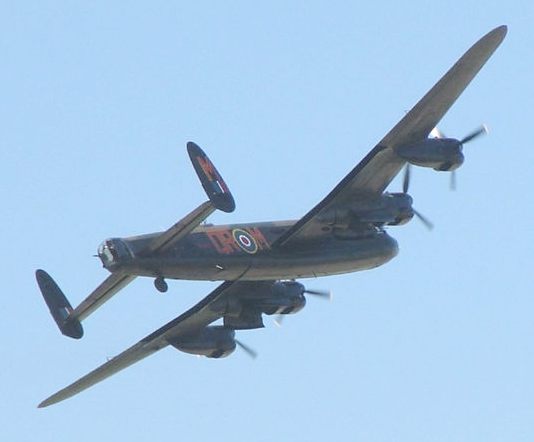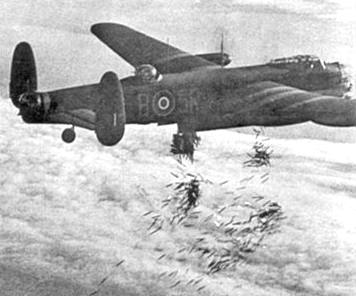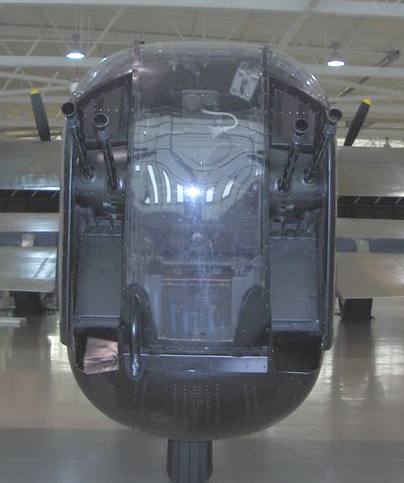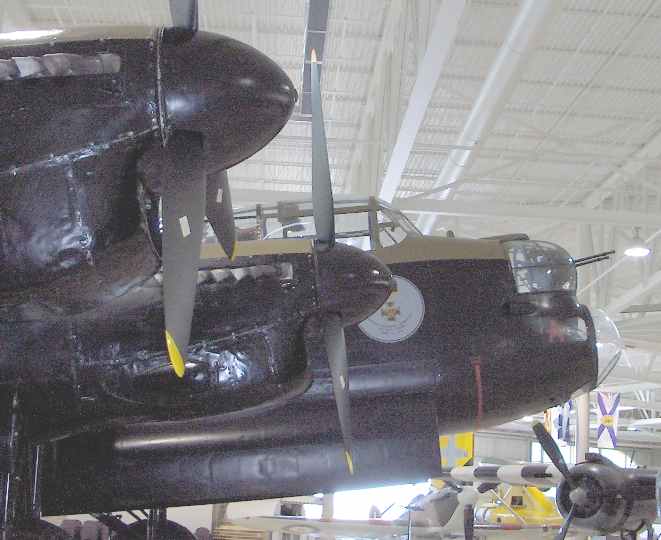|
The
Avro Lancaster was a four-engine World
War II bomber aircraft made initially by Avro for the Royal
Air Force (RAF). First used in 1942, together with the
Handley-Page Halifax it was the main heavy bomber of the RAF,
the Royal Canadian Air Force, and squadrons from other
Commonwealth and European
countries serving with RAF Bomber Command. The Lancaster was
primarily a night bomber.

Avro
Lancster WW2 Bomber aircraft
Battle
of Britain Memorial Flight 2005
History
The
origins of the Lancaster design was in a twin-engined heavy
bomber powered by Rolls-Royce Vulture engines submitted to Specification
P.13/36 which was for a new generation of twin-engined
medium bombers. The resulting aircraft was the Avro Manchester,
which although a capable aircraft was troubled by the
unreliability of the Vulture. It was withdrawn from service in
1942 by which point 200 aircraft had been built.
Avro's
chief designer, Roy Chadwick, was already working on an improved
Manchester design using four of the more reliable but less
powerful Rolls-Royce Merlin engines on a larger wing. The
aircraft was initially designated Avro Type 683 Manchester III,
it was later named the Lancaster. The new aircraft made its
first test flight on January 9, 1941, and proved to be a great
improvement on its predecessor. Most of the original Manchesters
were rebuilt as Lancasters; the designs were very similar, and
both featured the distinctive greenhouse cockpit, turret nose,
and twin tail although the Lancaster discarded the stubby
central tail fin of the Manchester.
The
majority of Lancasters during the war years were manufactured by
Metropolitan-Vickers, Armstrong Whitworth, and Avro. The plane
was also produced at the Austin Motor Company works in
Longbridge, Birmingham later in World War II. Only 300 of the Lancaster
Mk II with Bristol Hercules engines were made. The Lancaster
Mk III had newer Merlin engines but was otherwise identical
to earlier versions; 3,030 Mk IIIs were built, almost all at A.V.
Roe's Newton Heath factory. Of later versions only the
Canadian-built Lancaster Mk X was produced in any
numbers, built by Victory Aircraft in Malton, Ontario, 430 of
this type were built. They differed little from earlier
versions, except for using Packard-built Merlin engines and
having a differently configured mid-upper turret. 7,377
Lancasters of all marks were built over the war; a 1943
Lancaster cost £45-50,000
(approximately equivalent to £1.3-1.5 million in 2005 currency [1]).
Lancasters
from Bomber Command were to have formed the main strength of
Tiger Force, the Commonwealth bomber contingent scheduled to
take part in Operation Downfall, the codename for the planned
invasion of Japan
in late 1945, from bases on Okinawa.
Combat
History
In
1942-45, Lancasters flew 156,000 operations and dropped 608,612
tons of bombs. 3,249 Lancasters were lost in action. Only 35
Lancasters completed more than 100 successful operations. The
greatest survivor completed 139 operations and survived the war,
to be scrapped in 1947.

Lancaster I NG128 dropping its load over Duisburg
on Oct 14, 1944
An
important feature of the Lancaster was its extensive bomb bay,
at 33 feet (10.05 m) long. Initially the heaviest bombs carried
were 4,000 lb (1,818 kg) "Cookies". Towards the end of
the war, attacking special and hardened targets, the B1 Specials
could carry the 21 foot (6.4 m) long 12,000 lb (5,448 kg) 'Tall
Boy' or 25.5 foot (7.77 m) long 22,000 lb (9,979 kg) 'Grand
Slam' "earthquake" bombs. This required modification
of the bomb-bay doors.
The
Lancaster had a very advanced communications system for its
time; the famous 1155 receiver and 1154 transmitter. These
provided radio direction-finding, as well as voice and Morse
capabilities. Later Lancasters carried:
-
Oboe
- a very accurate navigation system consisting of a
receiver/transponder for two radar stations transmitting
from the UK - one determining range and the other the
bearing on the range. As the system could only handle one
aircraft at a time it was only fitted to Pathfinder aircraft
which marked the target for the main force. Later
supplemented by GEE-H, similar to Oboe but with the
transponder on the ground allowing more aircraft to use the
system simultaneously. GEE-H aircraft were usually marked
with two horizontal yellow stripes on the fins.
The
most famous use of the Lancaster was probably the 1943 mission,
codenamed Operation Chastise, to destroy the dams of the Ruhr
Valley using special drum shaped bouncing bombs designed by Barnes
Wallis, and carried by modified Mk IIIs. The story of the
mission was later made into a film, The
Dam Busters. Another famous action was a series of
attacks against the German battleship Tirpitz with 'Tall
Boy' bombs, ended with the sinking of the Tirpitz.
A
development of the Lancaster was the Avro Lincoln bomber,
initially known as the Lancaster IV and Lancaster V, these two
marks became the Lincoln B1 and B2 respectively. There was also
a civilian airliner based on the Lancaster, the Lancastrian.
Other developments were the York, a square-bodied transport, and
the Shackleton, which continued in airborne early warning
service up to 1992.
In
1946 four Lancasters were converted by Avro at Bracebridge
Heath, Lincolnshire as freighters for use by British South
American Airways, they proved to be uneconomical and were
withdrawn after a year in service.
Four
Lancaster IIIs were converted by Flight Refuelling Limited as
two pairs of tanker and receiver aircraft for development of
in-flight refuelling. One aircraft was flown non-stop 3,355
miles in 1947 from London to Bermuda. Later the two tanker
aircraft were joined by another converted Lancaster and were
used in the Berlin Airlift, they achieved 757 tanker sorties.

Avro
Lancster rear gun
Variants
B.I
The
original Lancasters were produced with Rolls Royce Merlin XX
engines. Minor details were changed throughout the production
series - for example the pitot head design was changed from
being on a long mast at the front of the nose to a short fairing
mounted on the side of the fuselage under the cockpit. Later
production Lancasters had Merlin 22s and later Merlin 24s. No
designation change was made to denote this change.
B.I
Special
Adapted
to take first the super-heavy Tallboy and then Grand Slam bombs.
Upgrated engines with broad bladed propellers gave more power;
the removal of gun turrets reduced weight and gave smoother
lines. For the Tallboy the bomb bay doors were bulged — for
the Grand Slam they were removed completely and the area faired
over.
B.II
Bristol
Hercules powered variant. 300 produced. These aircraft used
Hercules VI or XVI engines. One difference between the two
engine versions was the VI had manual mixture, leading to an
extra lever on the throttle pedestal to control mixture. These
aircraft were almost invariably fitted with an FN.64 under
turret and bomb bay bulge.
B.III
These
aircraft were fitted with Packard built Merlin engines, and
produced in parallel to the B.I. The two marks are
indistinguishable externally. The minor differences between the
two variants were related to the engine installation, and
included the installation of slow running cut off switches in
the cockpit, due to the SU Carburettors on the Packard Merlin
engines.
B.III
Special
Variant
built to take the "Upkeep" (bouncing)
bomb for the Dambusting raids. The struts and mechanism to take
the cylindrical bomb were fitted below the bomb bay and search
lights fitted for the simple height measurement system. The mid
upper turret was removed to save weight - the gunner was moved
to the front turret to allow the bomb aimer to assist with map
reading.
B.IV
Increased
wingspan and lengthened fuselage. Two-stage Merlin 85s - later
renamed Lincoln B.1
B.V
Increased
wingspan and lengthened fuselage. Two-stage Merlin 85s - later
renamed Lincoln B.2
B.VI
9
aircraft converted from B.IIIs. Fitted with Merlin 85s which had
two stage superchargers, for improved high altitude performance.
These aircraft were only used by Pathfinder units, often as
"Master Bomber".
B.VII
The
B.VII was the final production version of the Lancaster. Martin
250CE mid-upper turret re-positioned slightly further forward
than previous Marks. Frazer nash FN.82 tail turret with twin
Browning 0.5in machine guns replacing four-gun 0.303in FN.20.
B.X
The
B.X was a Canadian-built B.III, differing in having Canadian/US
made instrumentation and electronics. Also on later batches, the
Martin 250CE was substituted for the Frazer Nash FN.50 mid upper
turret. The greater weight of this turret necessitated moving
the turret forward for balance reasons. Canada was a long term
user of the Lancaster, utilising modified aircraft in Maritime
Patrol, Search and Rescue and Photo Reconnaisance roles until
1963.
Surviving
Aircraft
There
are 17 known Avro Lancasters remaining in the world, two of
which remain in airworthy condition, although few flying hours
remain on their airframes and actual flying is carefully
rationed. One is PA474 of the Battle of Britain Memorial
Flight and the other is FM213 of the Canadian Warplane
Heritage museum.
Among
the non-flying survivors are:
-
B.I
R5868 'S-Sugar' is the oldest surviving Lancaster.
Previously 'Q-Queenie', this aircraft flew 135 operations,
first as 'Q-Queenie' with No. 83 Squadron RAF from RAF
Scampton and then as 'S-Sugar' with No. 463 and No. 467 RAAF
Squadrons from RAF Waddington. This aircraft was the first
RAF heavy bomber aircraft to complete 100 operations, and is
now on display at the RAF Museum, Hendon.
-
B.I
W4783 'G-George' was operated by No. 460 Squadron
RAAF and completed 90 sorties. It was flown to Australia in
the war for fundraising purposes, and was assigned the
Australian serial A66-2. The aircraft was later placed on
display at the Australian War Memorial, Canberra, and
underwent a thorough restoration between 1999 and 2003.
-
B.VII
NX611 "Just Jane", served with the
Aeronavale until the 1960s, when it was flown back to
Britain. At one stage the aircraft was kept at Blackpool,
and following the removal of R5868 served as gate guardian
at RAF Scampton. NX611 now resides at the Lincolnshire
Aviation Heritage Centre at the former RAF East Kirkby, and
is frequently taxied on a length of the old perimeter track.
-
B.VII
NX622 served with the Aeronavale until 1962, when it
was donated to the RAAF Association. It is now beautifully
restored, and displayed at the RAAF Association museum in
Bullcreek, Western Australia
-
B.VII
NX665 with H2S radar is preserved at Auckland's
Museum of Transport and Technology. This aircraft served
with the Aeronavale until the 1960s, when it was presented
to the museum. The airframe originally lacked the mid-upper
turret, having been built with the mountings for a Martin
250CE. An earlier FN50 was retrofitted in the late 80's.
This required modifications to the aircraft's structure as
the turret mounts had to be moved rearwards.
-
B.X
FM104 was donated to the City of Toronto in 1964 and
placed on a pedestal on Lakeshore Drive. After sitting
outside for 36 years, the aircraft was removed from the
pedestal and placed on loan to the Toronto Aerospace Museum
in Toronto, Canada. The aircraft is now under long term
restoration to static display condition. With spare parts
from the remainder of FM118, it is slated to be complete as
a museum quality piece in 2015.
-
Mk.10P
FM212 was withdrawn from RCAF service in 1962 and
placed in storage. The city of Windsor, Ontario purchased
the aircraft for a memorial; it was mounted on a pedestal in
Jackson park in 1965. Unfortunately, weather and poor
maintenance had taken their toll on the aircraft and it was
removed on May 26, 2005. In its place are mounted a Spitfire
and a Hurricane replica.

Avro
Lancster cockpit
Notes
The
exact weight in kilograms of the 'Tall Boy' and 'Grand Slam'
bombs differs according to source. The figures given are the
most common.
Whilst
8 .303 in machine guns were the most common Lancaster armament,
twin .50 turrets were later available in both the tail and
dorsal positions. A Preston-Green mount was available for a .50
cal mounted in a ventral blister, but this was mostly used in
RCAF service. Some unofficial mounts for .50 cal or even 20 mm
guns were made, firing through ventral holes of various designs.
Operators
-
Argentina,
Australia, Canada, Egypt, France, New Zealand, Poland
(Government and Army in Exile during duration of War only),
United Kingdom.
SPECIFICATIONS
General
characteristics
-
Crew:
7, pilot, flight engineer, navigator, bomb aimer, wireless
operator, mid-upper and rear gunners
-
Length:
69 ft 5 in (21.18 m)
-
Wingspan:
102 ft (31.09 m)
-
Height:
19 ft 7 in (5.97 m)
-
Wing
area: 1,300 ft² (120.8 m²)
-
Empty
weight: 36 828 lb (16,705 kg)
-
Loaded
weight: 63,000 lb (28,636 kg)
-
Powerplant:
4× Rolls-Royce
Merlin XX piston engines, 1,280 hp (954 kW) each
Performance
-
Maximum
speed: 280 mph at 15,000 ft (448 km/h at 5,600 m)
-
Range:
2,700 miles with minimal bomb load (4,320 km)
-
Service
ceiling: 23,500 ft (8,160 m)
Armament
-
8x
0.303 in (7.7 mm) Browning machine guns in three turrets
-
Up
to 22,000 lb (10,000 kg) of bombs, typical load 14,000 lb
(6,350 kg)

This
Lancaster is carrying Airborne Cigar
(ABC) equipment
as
indicated by the two vertical aerials on
the fuselage
LINKS:
AVIATION
A - Z

Solar
Cola drinkers care about climate chaos
...
..
Thirst for Life

This
page is sponsored by Solar Cola
|
![]()
![]() logo and name Solar Navigator are trademarks.
All rights reserved. All other trademarks are hereby acknowledged.
Max Energy Limited is
an educational charity.
logo and name Solar Navigator are trademarks.
All rights reserved. All other trademarks are hereby acknowledged.
Max Energy Limited is
an educational charity.




